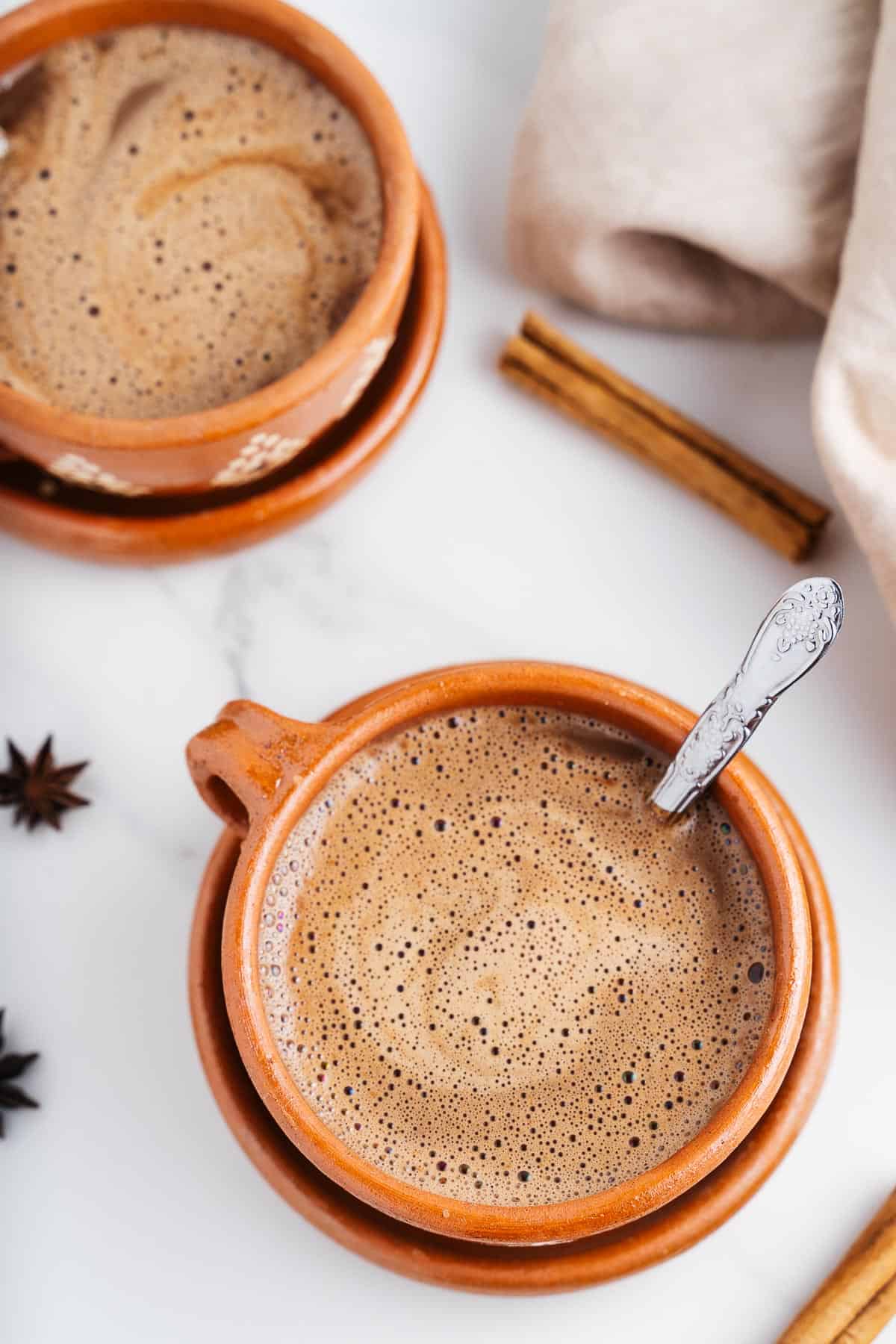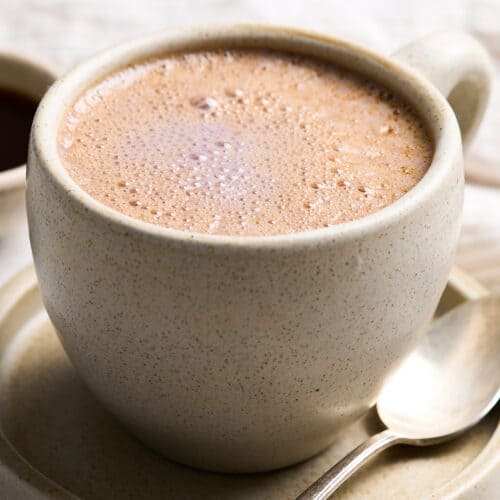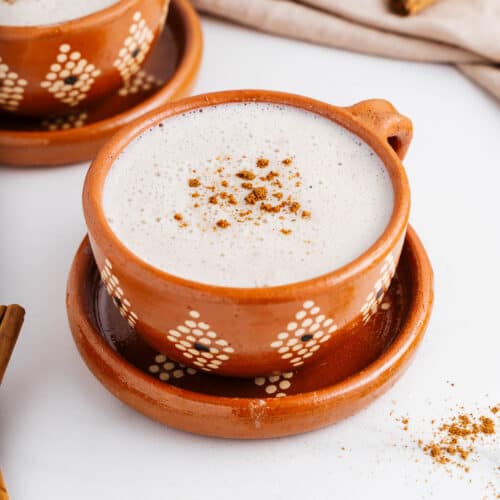Vegan Champurrado
This vegan champurrado is a rich, creamy, and sweet drink that combines the rich flavors of Mexican chocolate and piloncillo with the satisfying texture of masa harina. Cinnamon and star anise make it perfect for the holidays or as a way to warm up on a rainy day!

Despite its complex flavors, this vegan champurrado recipe is so simple to make! It’s the perfect choice to serve on holidays like Christmas and the Day of the Dead. If you’re a fan of cozy Mexican drinks, don’t miss my atole de arroz.
Why I love this recipe
With its chocolatey richness, this vegan champurrado feels indulgent yet satisfying and nourishing. I opt for soy milk rather than dairy-based milk, making this recipe ideal for anyone following a dairy-free or vegan diet.
Using just a few more key ingredients like masa harina, piloncillo, and Mexican chocolate, it creates a mouthwatering blend of flavors that’s hard to resist!
All you need is a pot and a whisk, and in under 30 minutes, your vegan champurrado is ready to serve. Enjoy it as a breakfast beverage, a comforting dessert, or a dip for sweet antojitos like pan dulce.
Ingredient notes
This vegan champurrado comes together with just 6 ingredients. Find a full breakdown and suitable substitutes below!

Spices
Whole cinnamon and star anise add a festive aroma and flavor. If possible, opt for Ceylon cinnamon sticks rather than cassia cinnamon.
Substitute: If star anise is unavailable, substitute it with a pinch of ground anise seed. You can also use ground cinnamon for a similar effect.
Masa harina
This corn flour gives champurrado its characteristic thickness. Cornstarch is another common option for thickening atole and champurrado, but I prefer the flavor of masa harina. Look for it at Latin American food markets.
Piloncillo
This unrefined cane sugar gives the champurrado a deep, molasses-like sweetness. It’s also known as panela in other parts of the world, so check for this as well. You should be able to find it in international aisles or Latin American food markets.
Substitute: You can swap piloncillo with coconut sugar or organic dark brown sugar for a similar effect.
Mexican chocolate
This special chocolate has a slightly grainy texture that becomes smooth once melted. It also includes spices like cinnamon, giving it a unique flavor profile. Look for it at Latin American food markets or online.
Substitute: If you can’t find Mexican chocolate, use a combination of bittersweet chocolate and a pinch of cinnamon.
Plant milk
Makes the drink rich, creamy, and comforting. You can use any non-dairy milk you prefer, like soy, oat, cashew, almond, or coconut. Use an unsweetened, plain variety.
For a complete ingredient list and step-by-step guide, scroll down to our recipe card.
How to make
Learn the best way to make a vegan champurrado with my step-by-step instructions. Look for the tips in green throughout this section for consistent and successful results! Also, you can watch my video tutorial down below!
Cooking
Step 1
Start by bringing a cinnamon stick, star anise, and water to a gentle boil in a pot. Lower the heat and let these spices simmer until they fill your kitchen with their festive aromas. Strain the water to remove any bits of the spices.
Whole spices add a more balanced flavor, so I always recommend them over powdered spices. If you use powdered spices, add them in step 3.


Step 2
While the spices are simmering, whisk the masa harina, salt, and hot water. This mixture forms the base of the champurrado, giving it a thick consistency. Grate or finely chop the piloncillo and Mexican chocolate to help them dissolve.

Step 3
Add the piloncillo, chocolate, and soy milk to the spice-infused water. Whisk continuously as you pour in the masa harina mixture. Let it simmer until it thickens into a creamy, dreamy beverage. Happy drinking!

Expert tip
To elevate your vegan champurrado from good to great, pay close attention to the consistency of the masa harina mixture. Whisk it thoroughly with hot water to ensure there are no lumps in the final drink.
Also, don’t rush the simmering process! Let the cinnamon and star anise fully infuse the water before adding the rest of the ingredients.
Never bring the champurrado to a rapid boil after adding the masa harina. A gentle simmer allows the flavors to meld beautifully without the risk of burning or sticking to the pot.
Serving suggestions
Champurrado is best served as a warm breakfast drink, a dessert, or as a side to treats like vegan churros and bunuelos. For a more indulgent flavor, top it with vegan whipped cream and a dusting of cinnamon or cocoa powder.
Whatever way you serve it, each sip feels like a warm, comforting hug, making it perfect for chilly days or whenever you need a comforting snack! For another Christmas season drink, try this alcoholic wassail.

Cooking tips
Chop the mix-ins: Grate or finely chop the chocolate and piloncillo to help them dissolve quickly.
Strain: Use a fine-mesh strainer to remove all traces of the spices from the water.
Smooth consistency: Whisk the mixture continuously when adding the masa harina mixture to avoid lumps.
Froth it: Use a molinillo or a blender to create a traditional frothy texture.
Mexican chocolate quality: Use high-quality Mexican chocolate for the most authentic flavor. Check out my Mexican chocolate post for ideas.
Frequently asked questions
Add more plant-based milk while heating it gently and stirring until you achieve your desired consistency.
Champurrado should be thicker than traditional hot chocolate. If it’s too thin, it might not have been cooked long enough. Let it simmer a bit longer on the stove. Remember, it will also thicken as it cools.
If your champurrado is lumpy, it may be because the masa harina wasn’t whisked continuously when you added it to the water. To prevent this, whisk the mixture constantly as you gradually add the masa harina.

Storing & reheating
This vegan champurrado is easy to store, making it perfect for enjoying over a few days. Before storing, let the leftovers cool to room temperature.
Fridge
Champurrado can be stored in the refrigerator for up to 3-4 days. To prevent it from absorbing other odors, use an airtight glass container or jar. The mixture may separate slightly when chilled, but this is normal.
Freezer
Champurrado can be frozen for up to a month. It’s best to freeze it in ice cube trays and then transfer the cubes to a freezer-safe bag.
Reheating
Gently reheat the champurrado on the stove over low-medium heat, stirring frequently to maintain a smooth consistency. If it’s too thick, add a bit more plant-based milk.
Watch how to make it
More hot drinks
Hungry for more?
If you enjoyed this recipe, please consider leaving a star rating and a comment down below! Your feedback not only helps others discover our blog but also gives us valuable insights from your experience.
Don’t forget to subscribe to our newsletter for the latest recipes, and check out our shop for our top kitchen recommendations. Thank you for supporting BBV!
Recipe

The Best Vegan Champurrado
Equipment
- Saucepan
- Knife or grater
- Whisk
Ingredients
- 1 whole cinnamon stick
- 1 whole star anise pod
- 2 ½ cups room temperature water
- 1 cup hot water
- ⅓ cup masa harina
- ⅛ teaspoon salt
- 1 ounce piloncillo
- 4 ounces Mexican chocolate
- 2 cups soy milk
Instructions
- In a medium-large pot, bring the cinnamon stick, star anise, and 2 ½ cups of water to a boil. Once boiling, lower the heat and simmer for 10-12 minutes. Strain the water to remove any chunks of cinnamon or anise, then add it back to the same pot.
- In the meantime, whisk the masa harina, salt, and 1 cup of very hot water together in a bowl or container. Stir vigorously to remove as many clumps as you can. Set aside.
- Grate or finely chop the piloncillo and chocolate, then add both to the pot of steeped water with the soy milk. Continue simmering, stirring occasionally, until the chocolate and piloncillo have dissolved, about 5 minutes.
- Slowly pour in the masa harina mixture while whisking continuously. Turn the heat up to medium-high until the mixture comes to a low boil, then reduce the heat and simmer for 10-12 minutes until thickened.
- Serve your vegan champurrado as a breakfast drink or dessert, or alongside snacks like churros, tamales, etc. Happy drinking!
Notes
Nutrition
Note: I’ve updated this post to include new information and helpful tips about the recipe.
Justine Drosdovech is a food writer, photographer, and one of the founders of Broke Bank Vegan. She is a self-taught plant-based chef but uses her healthcare background to craft dishes that are both delicious and nourishing.





